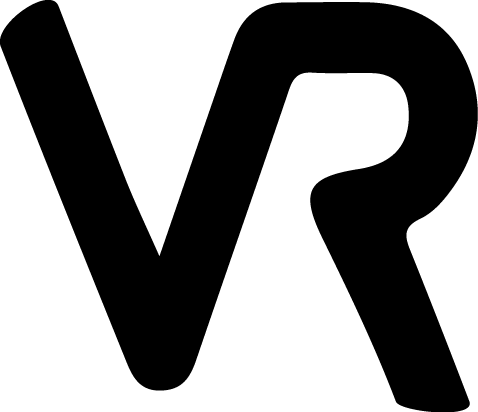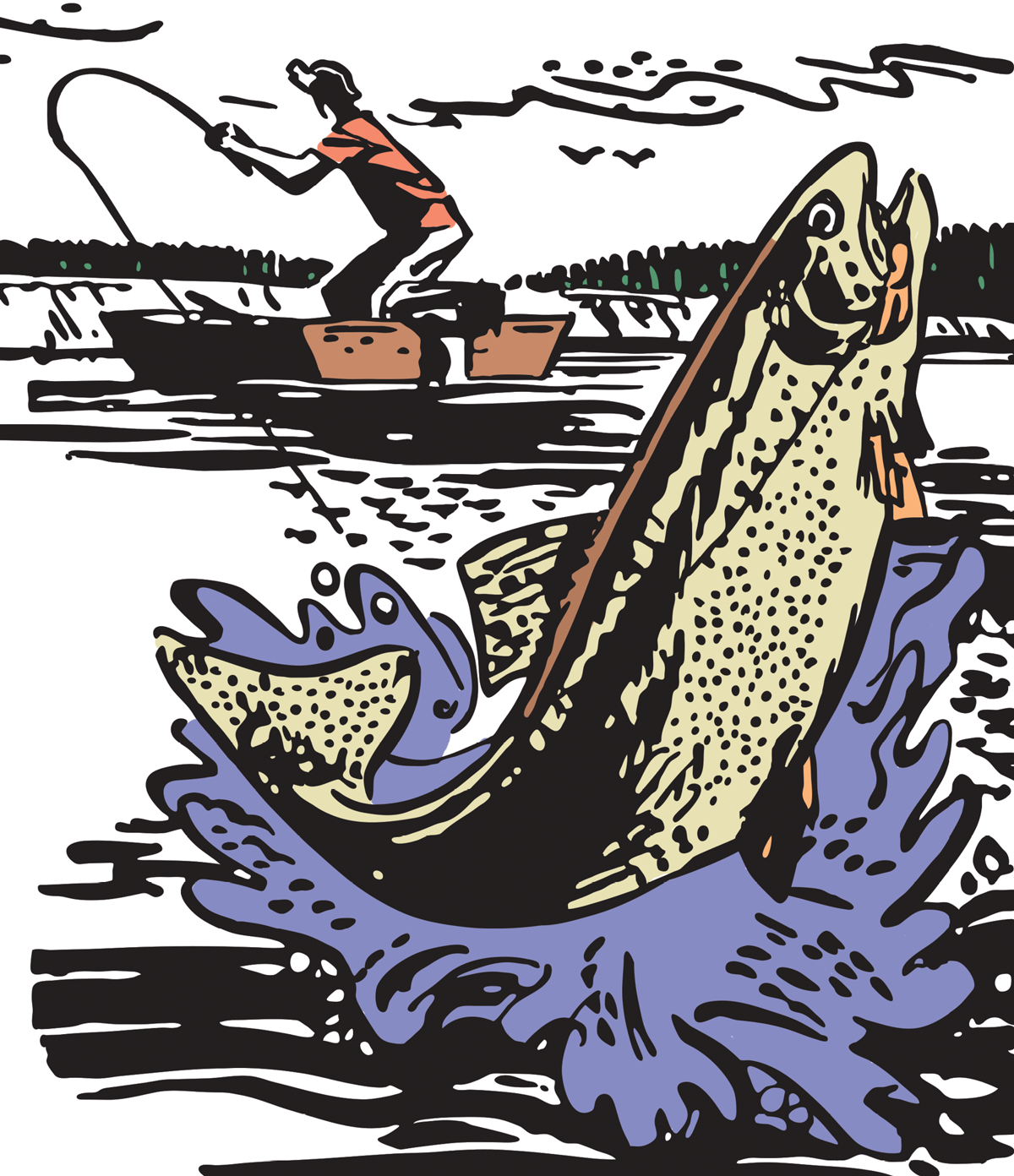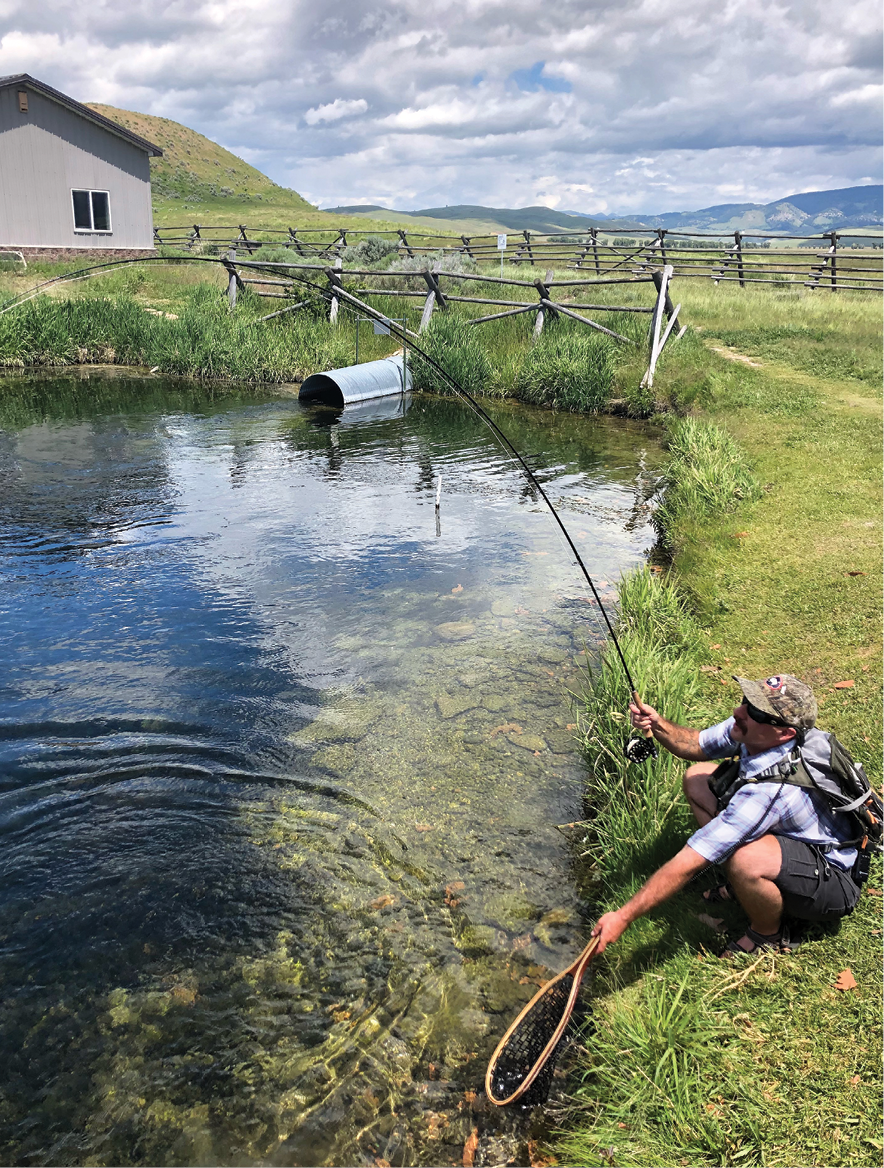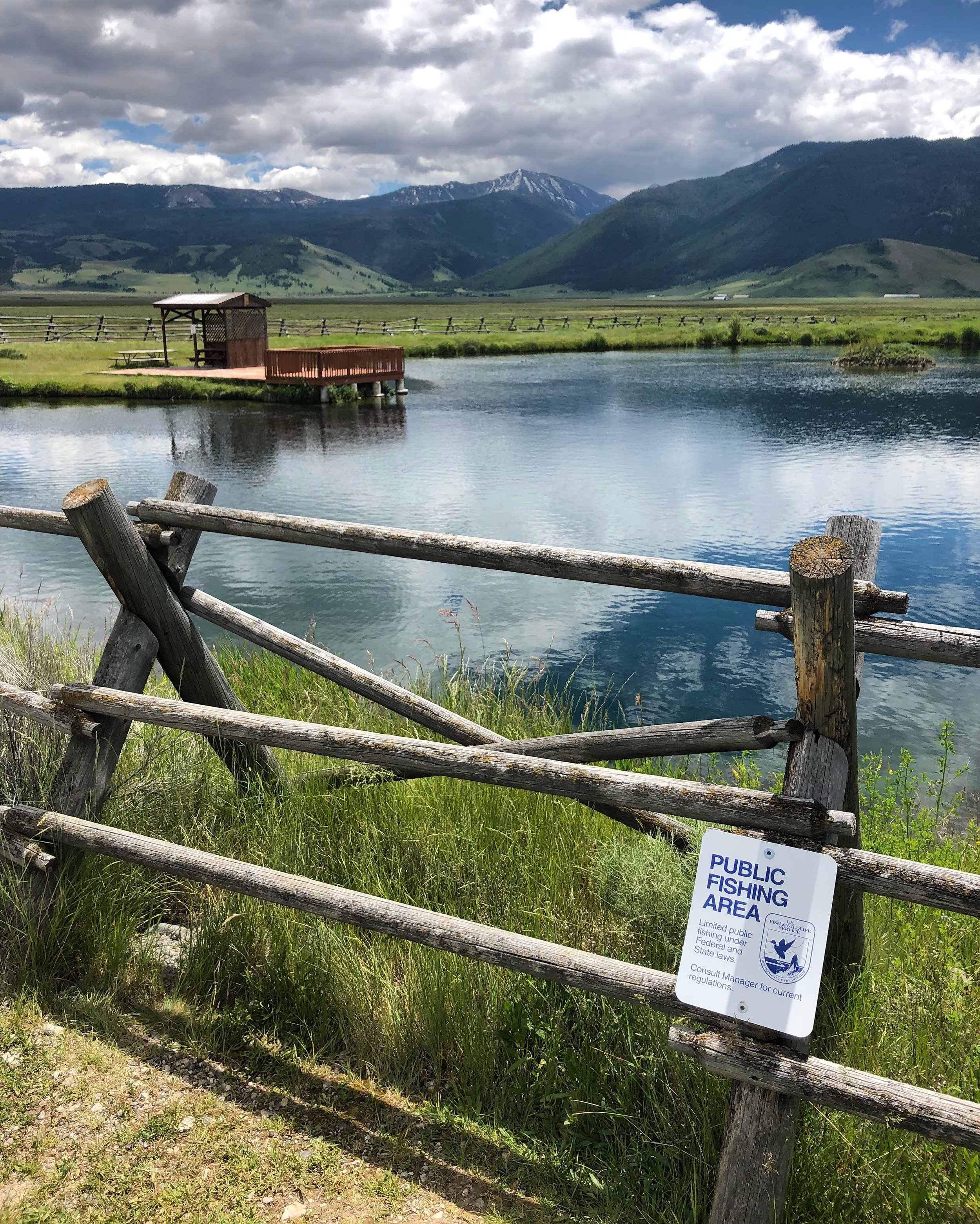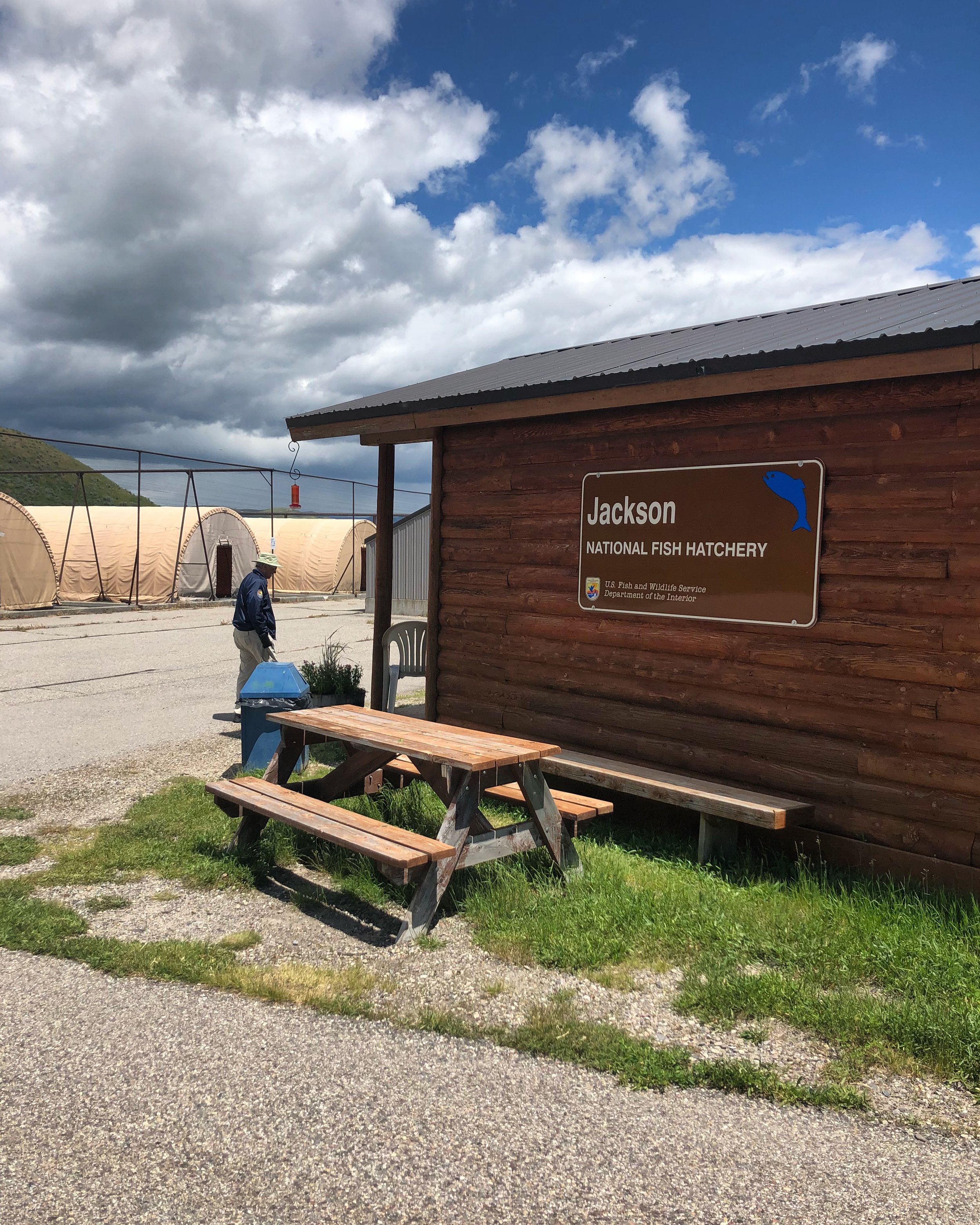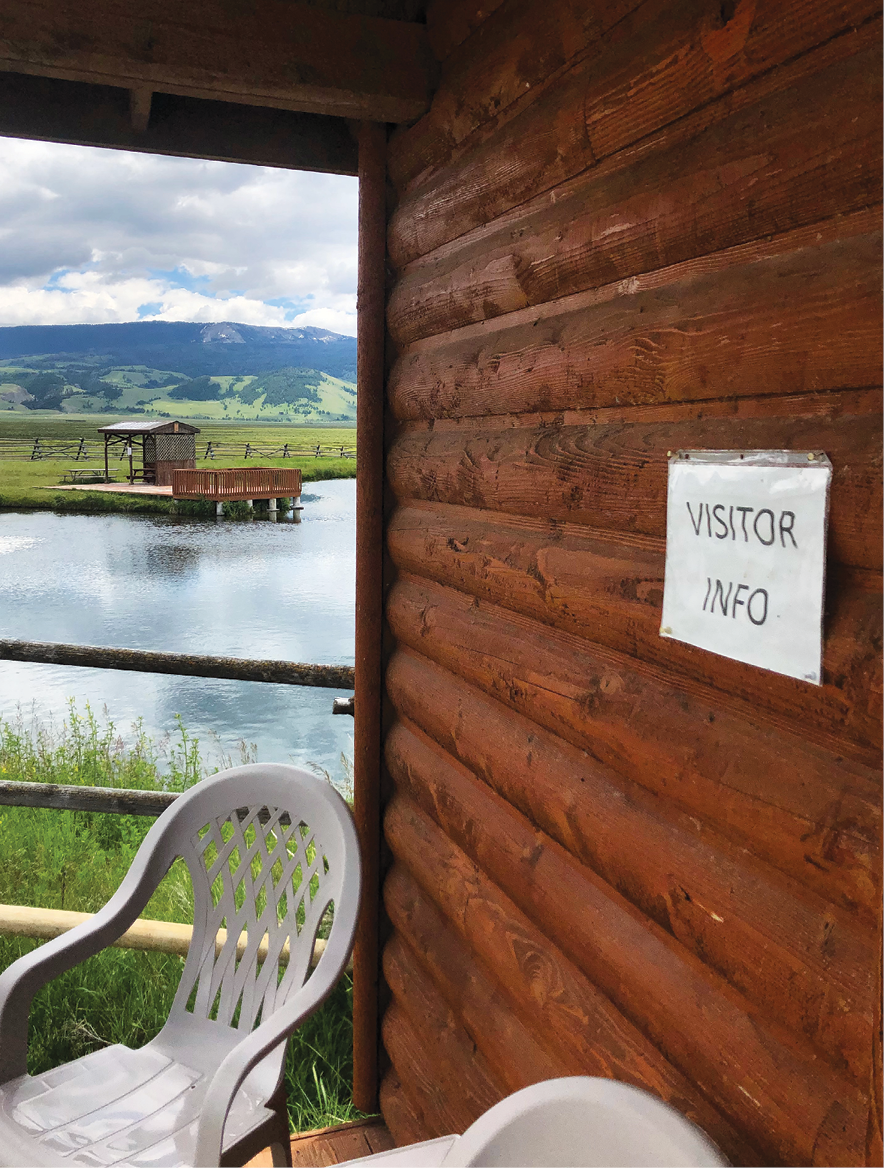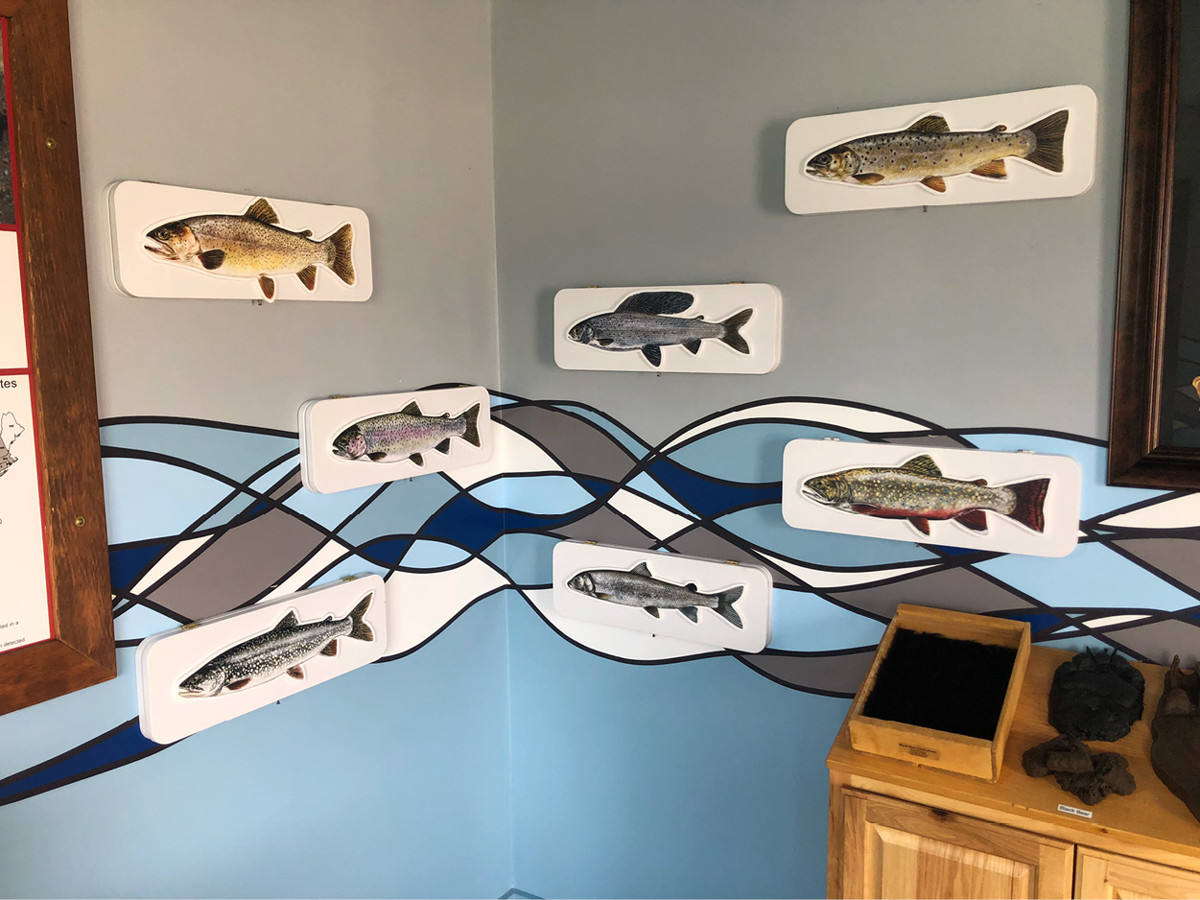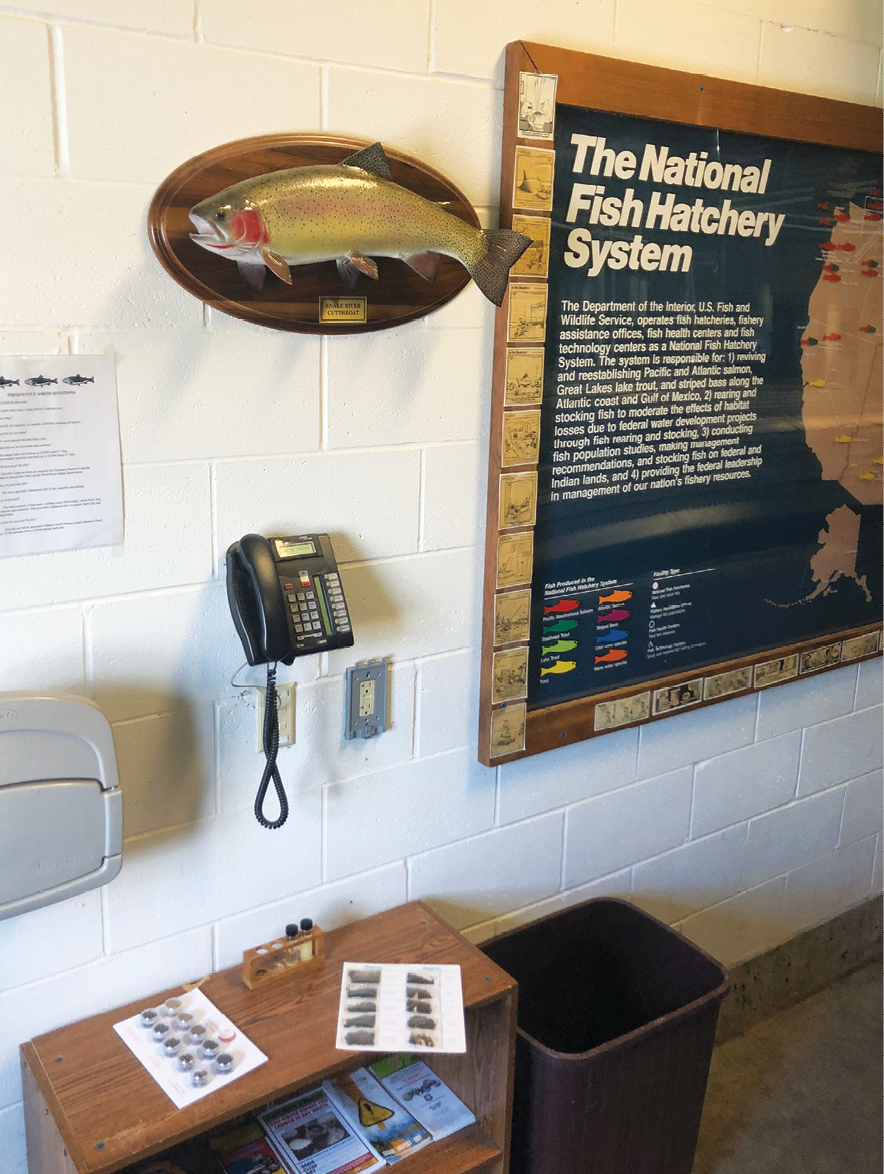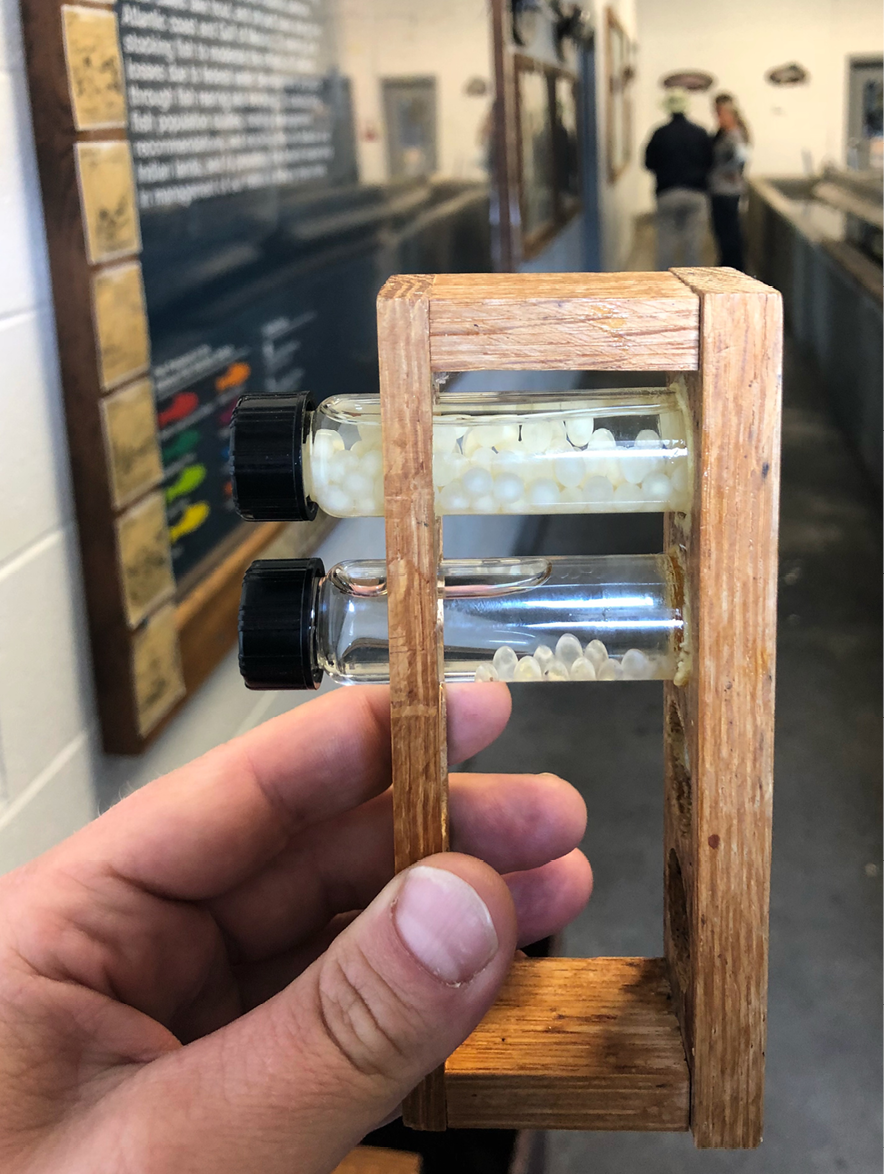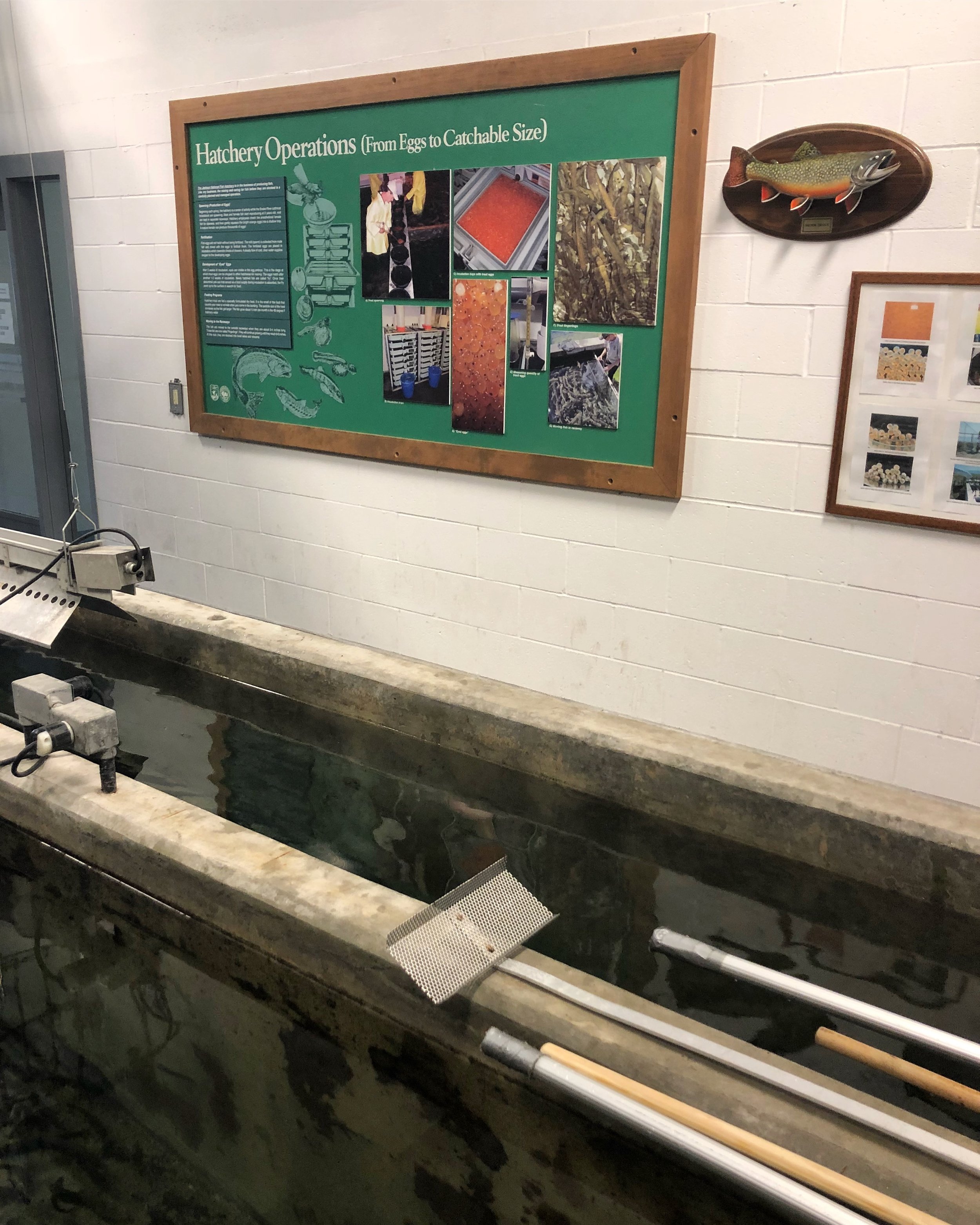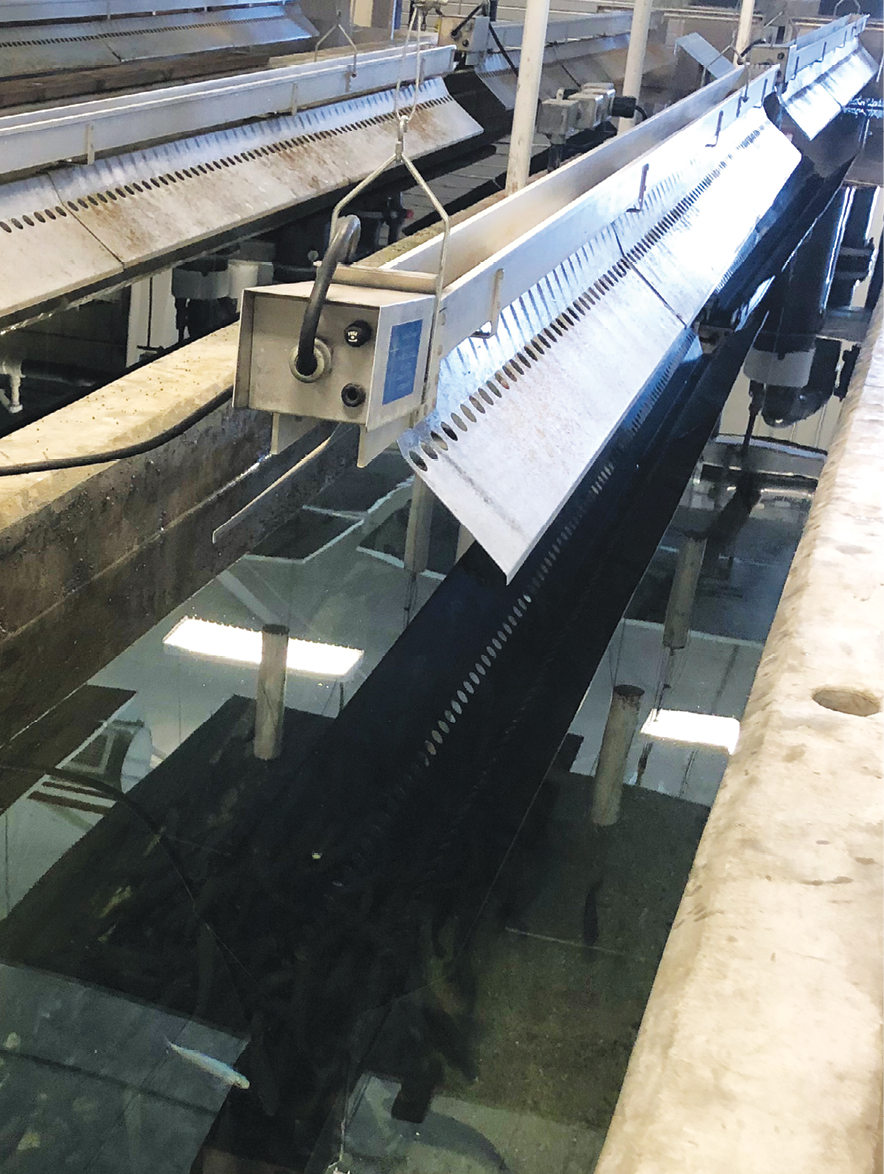This feature was originally published by Planet Jackson Hole as the cover story for their July 25, 2018 print issue.
MISSING THE BOAT
Jackson Hole casts itself as a place for visitors to recreate in tandem with conservationism. But is it adrift in an opportunity to use a nearby federal fish hatchery to support the performance of its role?
An angler perched near Sleeping Indian Pond’s intake culvert from Flat Creek whips his fly toward a group of fish in the clear, placid water feature at Jackson National Fish Hatchery (JNFH). The pond is a half-acre public fishing area abutted by a wheelchair-accessible dock with latticed-gazebo, and rimmed by the region’s iconic buck-and-rail fencing. A steel U.S. Fish and Wildlife (USFWS) sign affixed to the fence advertises the pond’s “limited public fishing under federal and state laws” and suggests anglers “Consult manager for current regulations.” The lone angler won't keep anything he catches today, but claims that it's “good place to practice casts and get some action when the nearby rivers are blown out.”
It’s late June, the day after the summer solstice, and the nearby Snake River and its tributaries, the Hoback, Grays and Salt rivers are raging.
To the south, the town of Jackson itself is engorged in a similar chaos of tourists clamoring elbow-to-elbow along bespoke wooden boardwalks. To the north, Grand Teton National Park, too, bustles with oversized tour busses escorting visitors from one scenic vista to the next predetermined point of interest. Nearby campgrounds, even remote ones, are at capacity. At a site along the banks of the Gros Ventre River, a group of high schoolers set up camp and fantasize about their potential wildlife sightings for the weekend to come.
It’s the informal start of the region’s traffic-jamming tourism season that is centered on outdoor recreation and encounters with wildlife in a tightly-guarded ecosystem. It is a season, the angler said, that “never really ends anymore.”
The hatchery, wedged between a town that casts itself as a hotbed for conservation and a string of high-traffic national parks, attracts an estimated 10,000 visitors annually. On this afternoon, as trophy-sized, hatchery-raised trout swim past the angler’s fly, it is host to just four. Such numbers are a drop in the bucket of Jackson’s 2.6 million annual guests, and an even smaller portion of the 4.8 million-and-climbing annual visitors to Grand Teton.
On the surface, the sleepy hatchery reads as on operation whose mission is to bring “recreational angling opportunities and healthy aquatic ecosystems to you, your family, and future generations.” Looking deeper, however, its assignment is a charge from the federal level, steeped in collaboration with at least nine national, state, local and tribal entities, as well as various civic and school groups and nonprofits. JNFH and its programming are a free, accessible public touchpoint for the town of Jackson to play up its role as a place that delivers conservation in motion to visitors and residents.
Teton County recently reaffirmed its stance on fisheries conservation when it rejected a proposal open for public comment by Wyoming Game and Fish that would standardize catch limits across trout species. That proposal would allow anglers fishing bodies of the Snake River watershed within the county that encompasses Jackson to retain two more cutthroat trout in the 12- to 16-inch range than the current size limits of three cutthroat trout, but only one measuring greater than 12 inches.
The input is what Wyoming Fisheries Management Coordinator David Zafft decribes a result of “social regulations,” with Teton County residents the sole commenters on the statewide call for input. “There was not a single comment elsewhere in the state opposing that change,” he noted. The goal was to standardize stream regulations throughout the state, and a state regulation is imminent with the exception of Jackson, Zafft explained.
“I think that’s fine,” he said. “These are, in many ways, social regulations and that change was not acceptable to the folks in Teton County.”
Zafft’s reference to “social regulations” stems from a survey that reports Wyoming’s already low catch-and-release rates. Statewide, anglers retain 1 percent or less of their total landings, a number that has fallen from 15 or 20 percent in the last 50 years.
Echoing public comment, the office manager of a local guide shop spoke to the economic value of catch-and-release practices. “Anything that protects the fishery and keeps people from keeping large fish, I’m definitely for that, because that’s our living,” explained Bruce James of Grand Teton Fly Fishing. “Those fish are your business partners when you’re in the fishing business and you don’t kill your business partners.”
However, Jackson may be missing an opportunity to broaden its social identity as a community that values the ties between conservation and outdoor recreation so much as to sell itself as a place for visitors to play with the notion. JNFH, too, may be underplaying an opportunity to serve as an educational platform that also contributes 50,000 angler days of recreational fishing valued at more than $5 million to the local economy. Together, the town and the hatchery may be adrift in a chance to communicate their interconnectedness in the multi-faceted approach to maintaining the region’s world-class trout fishery that serves residents and visitors alike with both catch-and-release and catch-and-retain angling opportunities.
It's an opportunity that starts at the hatchery just north of Jackson.
Open daily, with the exception of federal holidays, the hatchery delivers, free of charge, “many exciting visitor opportunities,” as the website reads. Visiting the hatchery is a chance to view long-range environmental planning in action. It’s also an educational opportunity to watch fish in a controlled environment, and witness the early stages of their lifecycle outside of fragile, generally inaccessible viewpoints of nearby stream bottoms where the process occurs naturally. The hatchery also is a chance to communicate how the trout raised there play into the puzzle-like framework of the region’s ethos that connects outdoor recreation and conservationism.
Like the interpretive displays that educate national park visitors to the north, JNFH’s site says there’s an interpretive cabin that contains information on local animals, fishing and invasive aquatic species. From the parking lot that sits above and looks down on the facility, the cabin is obstructed by the imposing, beige warehouse that is nursery to the 200,000 Snake River finespotted cutthroat trout (Oncorhynchus clarki behnkei) it raises, and sits adjacent to Sleeping Indian Pond off Flat Creek, the water source that floats the operation. The cabin’s small size and rustic character reference an aesthetic that the region has conditioned visitors to believe as authentic and inherently natural, which contrasts sharply against the utilitarian, industrial warehouse that serves as the fishes' seasonal home.
An oversized sign with United States Fish and Wildlife Service insignia flanks the west side of the cabin, and a simple paper sign slipped into a plastic sleeve and thumb-tacked to the cabin’s rustic lodgepole siding on the porch displays “VISITOR INFO.” Another slightly more stylized sign explains five federal fishing regulations, and the do-it-yourself presentation of the latter two signs are, despite best intentions, a harbinger of what’s to come once inside.
The cabin’s interior walls are emblazoned with modern, geometric graphics in monochromatic hues of blue and gray that, rather conceptually, provide a stream for more traditional scientific cutouts of local trout species to swim through. The cutouts flip upward to reveal text about the fishes’ appearance and distinguishing colors and markings of the species, as well as weights and measures for their respective state records. For example, the Snake River cutthroat trout cutout informs visitors that they are “native,” which is shorthand for a non-introduced (like rainbow and brown), non-invasive (like lake trout) and a “flagship species,” as Jackson Hole Conservation Alliance refers to them.
But the cutout doesn’t mention some key information—that the cutthroat’s “red/orange slash under lower jaw” is an identifying namesake that pairs with “numerous very fine spots” as their visual cues for anglers to identify them. “Spring spawn” is a simplified way of explaining when they reproduce by using their tail to dig nests in gravel beds of streams, which is often prohibited by sediment input and redistribution in the stream. Jackson Hole Trout Unlimited, as one of the hatchery’s partners, has helped mitigate this on Flat Creek just next to the hatchery. And there’s no mention that the record-setting “32 inches/15 lbs” fish was caught by Alan Dow in 1959, or that Native Lake in Sublette County where it was caught is outside the drainage basin that lends the geo-specific subspecies its name. Likely, the record belongs to a related subspecies, Colorado cutthroat trout. But true to the website, there’s “information on local animals,” including a replica of black bear scat.
On the cabin’s porch, two white plastic chairs offer respite and a view of Sleeping Indian Pond for guests and the volunteers who serve as the hatchery's interpretive guides between Memorial and Labor days. One of the chair’s part-time occupants, a white-haired woman named Donna Driver, greets guests in her navy National Elk Refuge windbreaker with a warm smile and an arsenal of information. Driver’s training for the volunteer position was simple and straightforward.
Hatchery administrators give volunteers “our own detailed tour and if they don’t know something, they can ask questions,” said Liz Sunshine, supervisory fish biologist and project leader for JNFH. “At the end of the summer, they probably know more than we do.”
Both biologist and tour guide are very familiar with summer’s star attraction at the hatchery. Almost immediately after her introduction, just off the steps of the cabin's porch, Driver mentions “Elsa.” She motions her hand toward the beige warehouse and swiftly makes her way toward from the rustic cabin to the industrial goliath.
Driver pauses at the door and begins to recite a script she’s committed to memory in her short volunteer tenure. She and her husband, David, recently sold their home in Virginia and headed west with a travel trailer. Now, she said, “home is wherever we park it.” These fish, too, are nomads, she hints, bridging her personal narrative and pre-rehearsed speech. The eggs aren’t harvested or fertilized here, but rather in Auburn, which is “somewhere in Idaho,” she said.
Auburn is another fish hatchery two hours south of Jackson, just over the Wyoming-Idaho border along the banks of Webster Creek that runs between Caribou National Forest’s West Hills and the Caribou Mountains. Not a federal operation, but supplemental to one, Auburn is operated by Wyoming Game and Fish through an agreement with Idaho and the Forest Service, and maintains the nation’s Snake River finespotted cutthroat trout broodstock. That broodstock is a group of sexually-mature fish that are manually spawned to produce between 3 and 4 million fertilized eggs per year. The fertilized eggs are incubated for a few weeks before being disbursed to other hatcheries, such as JNFH, for the second leg of their nomadic life cycle.
Driver, the tour guide, segues back to her script and explains that the eggs arrive when embryonic eyes appear. She hands over a wooden crate that encases two glass vials, each encapsulating a handful of small white eggs embalmed in their developmental stage. One set of eggs has black, pinprick-sized eyes that are barely visible through the opaque shell, while it’s complement’s eggs are eyeless.
The handheld display has slots for four vials, and theoretically, each would showcase the stages of trout development. The third vial would display alevins, the next step in which trout are nourished by an egg sac that remains affixed to their abdomen after writhing through their shells. The fourth would demonstrate fry, the growth following the absorption of their embryonic appendage, marking their new dependance on hunting for food. The hatchery raises fish through both stages, but prohibits public viewing of live specimens from egg to alevin to protect them in their fragile states, Driver said.
Driver jumps a little as a loud click echoes through the warehouse and automated feeders dispense a crumbled ration of fish, soybean and blood meals, wheat, fish oil, vitamins and minerals into the 48-degree water. A cacophonous splashing of hungry fry rising to the surface of four rectangular cement tanks follows, which happens every 15 to 30 minutes during a 12-hour period each day.
The guide continues her stroll as she walks along the edge of tank No. 12, occasionally peering into the clear water teeming with thousands of 4- to 6-inch trout mellowing down after their quick meal. She turns back and mentions the movie Frozen, Disney’s animated musical comedy in which a princess named Elsa accidentally sends her kingdom into a state of eternal winter. The plot follows Elsa as she shamefully banishes herself from her public. “So you know Elsa’s hand” Driver said, extending one of her hands. It’s the character’s magic blue extremity that was responsible for setting the icy stage of the film. “This fish is Elsa,” she said, pointing in the tank.
A frosty blue fish treads through the water. A rare “genetic recession,” Driver said, causes the stark appearance. Not only does the color of the anthropomorphized fish cruelly distinguish it from it’s brown schoolmates, but behaviorally it’s also an anomaly that swims almost solitarily as the others group together. Just like in the movie. Driver thinks that Elsa and her tankmates all know that she’s different, and mentions that she’s a little sad the outcast will be released in the fall as part of the third leg of their nomadic narrative.
From the hatchery, Elsa will be loaded into a tank and trucked in on of two directions. Either she'll head south, and pass through the town of Jackson before being unloaded into the waters of the Palisades Reservoir with 150,000 other fish to be managed by Wyoming Game and Fish and Idaho Fish and Game. Or she'll head east with the remaining stock, over the Gros Ventre Range and to the Wind River Indian Reservation’s Moccasin or Din Woody lakes as part of the hatchery’s collaboration with the Northern Arapaho and Eastern Shoshone tribes.
Elsa would fare just fine against the modern graphics of the interpretive cabin’s walls, but at either destination, her color marks her as an easy meal for predators. She likely won’t last long enough to meet the end of an angler’s line as the fourth and final part of her narrative that is predetermined by the hatchery’s mission statement that was developed nearly 70 years ago.
In 1950, Congress passed the Palisades Dam Act to harness the flows of the Snake River’s headwaters to produce hydro-electricity and provide a manageable water supply for drought-stricken and flood-prone areas. As a result of the Palisades Project, which includes the dam, reservoir and power plant, an ecological transformation ensued across the 5,200-square-mile drainage basin in Western Wyoming and Eastern Idaho. A large portion of the once-arid West became lush, arable and agriculturally rich.
The act also preemptively offset population losses from the obstructed watershed by developing facilities to preserve fish and wildlife numbers along the Snake River’s headwaters via the Fish and Wildlife Service. As part of the congressional directive, JNFH began its operation of raising fish to stock this slow-pooling stretch of the Snake River that straddles the Wyoming-Idaho border, and was quickly advertised as a recreational wonderland upon its completion.
Not just downstream from the dam, but also upstream from the reservoir, the Snake River and its tributaries are an ecological and economic lifeforce for the region. From its headwaters in Yellowstone and Grand Teton national parks, the Snake River flows into Jackson Lake’s watery reflections of the Teton Range that are cut by the bows of kayaks and scenic cruisers. From there, it meanders through the Jackson Hole geographic feature flanked by the Gros Ventre Range to the east and the Tetons to the west. Snowmelt from the slopes of these ski resort-dotted peaks help feed the streams that make the region a world class fly fishing destination. Regardless of the section and the niche it serves, the Snake River basin helps float the region’s recreational opportunities for its booming tourism industry. It is an industry the hatchery helps sustain to a tune of $5 million annually.
“Jackson Hole is one of the few destinations where in the springtime you can ski in the mountains in the morning and fish the rivers and streams in the afternoon,” said Kate Sollitt of the Jackson Hole Travel and Tourism Board (JHTTB), an organization tasked with luring visitors to the area that also speaks to its environmental ideologies as a selling point.
“It is very important to share with the rest of the world what we as a community value and that is conservation and outdoor recreation,” Sollitt said. Those values “have developed in tandem in Jackson and we showcase both in our promotional efforts.”
Not only is the town’s rapid development in modern years centered around those values, but it also rapidly cashes in upon them. The wooden boardwalks that tourist clamor upon speak to the towns aim to preserve and conserve character of a place that frames itself as unremoved from the natural world as possible, just as large swaths of once-ranchland on the town's outskirts have been entrusted to environmentally-minded development groups to build luxury housing for transplants to live in harmony with the existing wildlife residents. The shops that line Jackson’s main streets, too, are loaded with everything from outdoor recreation gear and apparel, to souvenir trinkets and artwork, all that feature wildlife motifs. Sollitt echoes the solicitation, and mentions the importance of wildlife viewing as “the fabric of our community and something we share with our visitors.”
Wildlife viewing is also sold by the Fish and Wildlife Service as a key attraction on the websites for both the hatchery and the National Elk Refuge it manages, where the hatchery sits. It’s a chance that visitors readily cash in on, though the disparity in elk refuge versus hatchery visitation numbers is notable. In December 2016, 8,291 visitors took sleigh ride tours in the refuge. By comparison, that number nearly accounts for the estimated 10,000 visitors the hatchery sees annually, the majority of which are in the summer. It’s a comparative figure at first glance, until paired with the refuge’s total visitors, a number that’s still represented modestly. Due to the refuge’s multiple entrance points, it’s “difficult to collect data,” said Lori Iverson, visitor service manager and elk refuge spokesperson. “We don’t have a way to manually count other than at the visitor’s center.” The refuge’s visitor center hosts 323,967 guests annually, a number that is still by no means exhaustive to the refuge’s 25,000 total acres.
It further contrasts the humble little hatchery as part of the second busiest national wildlife refuge of the federal government’s greater 562 locations. The busiest is coastal Virginia’s Chincoteague National Wildlife Refuge. Akin to the elk refuge’s oversized wildlife attractions, Chincoteague also offers viewers a look at charismatic megafauna with a herd of approximately 150 wild ponies, descendants from a once-domesticated group of horses. Those ponies were cemented in the public psyche by the 1947 children’s novel Misty of Chincoteague. It was published 66 years before Elsa the animated character sparked countless children singing the song “Let it Go,” and 71 years before Elsa the fish swam through her tank, and tour guides looked to her as a pop-culture reference to hook visitors and plant the seeds for the next generation of conservationists as they stopped by the hatchery on family vacations.
This hatchery recognizes its position, both physically and structurally, for fostering an appreciation for fish and their conservation. But that relationship may not be entirely reciprocal with its partners who work to sustain Jackson’s identity through place-based conservationism. It’s a question of differing environmental ideologies—those that create clear delineations between the value of wild and supplemented. They are ideologies hinted at in JHTTB's ‘StayWild’ marketing campaign, which Sollitt says is "featuring ways that our community and non-profits in our town make sure to keep Jackson wild.” And they're ideologues reinforced by the hatchery's non-profit partners.
The hatchery does “a great job and are willing to work with us,” said Leslie Steen, project coordinator for Jackson Hole Trout Unlimited, the local chapter of the nationwide nonprofit. Its conservation approach, its website reads, “should be a true partnership between landowners, agencies, municipalities, and all stakeholders.” That partnership is rather limited with the hatchery, however, Steen said, based on the hatchery and Trout Unlimited serving different parts of the same watershed and their individualized missions that respectedly serve supplemented and wild fish.
“To the best of my knowledge, there is no stocking in natural streams, just the reservoir” Steen said, distancing her organization from the hatchery. “We don’t have any restoration projects for the reservoir.”
In terms of youth outreach, Trout Unlimited understands the need to engage with young people to cultivate the next crop of conservationists. It works every year with nearly 200 seventh grade students from Jackson Hole Middle School to “adopt a trout.” That program grants students across the country an opportunity to oversee the wellbeing of fish that are implanted with trackable telemetry tags. Students monitor the fish’s movements through the “natural streams” that each local chapter works to restore. “Many of the students name their fish,” Steen said with a chuckle. But Steen didn’t seem entirely convinced that an increased partnership with the hatchery would add value to educational outreach opportunities. In terms of events that include the hatchery, “there isn’t much,” she said.
As part of the adopt-a-trout program’s curriculum, the nonprofit holds a combination of field and classroom activities about fisheries and watershed. During one of those days, other nonprofits descend upon the hatchery for a field day in which students cycle through various stations to learn about the importance of water quality, healthy watersheds and even to practice their hands at fly-casting. It’s an experience that sounds much like a practical synthesis of the hatchery’s mission to “bring recreational angling opportunities and healthy aquatic ecosystems to you, your family, and future generations.” Similarities aside, however, this is the only day a year that Trout Unlimited formally visits the hatchery or uses it as an educational platform.
Wyoming Game and Fish also has one day a year in which the hatchery becomes a classroom for fisheries education and community outreach. Each year in June, the agency recruits Jackson volunteers to assist in removing an adipose fin from the hatchery-raised fish, a cosmetic procedure that allows anglers and biologists to differentiate the supplemental hatchery stock from their wild-born counterparts, the ones organizations like Trout Unlimited emphasize protecting.
Donned in water-tight gear provided by the state, volunteers wade through the hatchery’s canvas-covered rearing ponds as they work in tandem with state biologists to perform the painless operation. It requires no prior experience, just the willingness to learn. That wasn’t lost on Jackson resident Shane Kappler. “That’s why I came—to learn more,” he said of his volunteer stint in 2014. “The more I help, the more I catch.” It’s a model for angler education and community involvement that is replicated at fish production facilities across the country.
Back at the hatchery, biologist and project supervisor Sunshine echoes the general sentiment of a willingness to work with their partners, on top of an appreciation for the hatchery’s visitors and education-oriented volunteers. Still, Sunshine is “not completely sure” why visitation numbers are low, especially in comparison to the nearby elk refuge. She suspects there is “only so much time” for visitors to take on the multitude of activities that Jackson Hole offers to them.
“I don’t think people can do everything,” Sunshine said. In fact, it’s not uncommon for visitors to stop by who are on their way to the airport. “We’ve done our best to get people here and are happy with what we get.”
